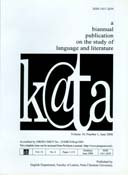Transcultural Hamlet Representations of Ophelia and Gertrud in 21st-century Iran
Abstract
Multitudes of intermedial Shakespearean adaptations have captured Iranian theatrical stage, cinema or radio as the Bard’s texts are frequently modernized, transfigured and indigenized especially since 1975. Hamlet works well in the mechanisms of temporality, spatiality, power, control and sexuality, socio-political discourses, economic upheaval, female self and gender struggles even in the twentieth and twenty-first centuries. Hence, Iranian directors such as Varuzh Karim-Masihi and Arash Dadgar as well as the British director Gregory Doran have re-interpreted this text based on new ideological grounds in which the characters are at times similar or different. In this article, the transformation and characterization of major characters, especially female ones such as Gertrud/Mah-Tal’at and Ophelia/Mahtab, are analyzed based on Hutcheon’s Adaptation Theory and Foucault's surveillance to see how they are represented in an Asian society whose Islamic ideology necessitates a unique transcultural, transhistorical rendition. The comparative study of these works reveals that since Shakespeare’s era, women's social representations have gone under great changes although the governments' surveillance has largely increased.
Downloads
References
Anderegg, M. (2003) Cinematic Shakespeare. Berkeley: Rowman & Littlefield.
Bloom, H. (2010). Bloom’s Modern Critical Views: William Shakespeare’s Tragedies. Infobase Publishing.
Burnett, M. T. (2007). Filming Shakespeare in the Global Marketplace. UK: Palgrave Macmillan.
Cooper, B. L. & Condon, R. A. (2004). The Popular Music Teaching Handbook: An Educator's Guide to Music-Related Print Resources. Libraries Unlimited.
Foucault, M. (1982). “The Subject and Power.†Michel Foucault: Beyond Structuralism and Hermeneutics. 2nd edition. Ed. Hubert l. Dreyfus and Paul Raninow. Chicago: U of Chicago Press.
Greenblatt, S. (2004). “Shakespeare and the Exorcistsâ€. Literary Theory, an anthology. Ed. Julie Rivkin and Michael Ryan. 2nd ed. Blackwell Publishing.
Hutcheon, L. (2006). A Theory of Adaptation. New York: Routledge.
Hooglund, E. (2002). Twenty Years of Islamic Revolution: Political and Social Transition in Iran Since 1979. New York: Syracuse University Press.
Karim-Masihi, V. (2009). Tardid. Iran.
Jalili Kohne Shahri, Kh. & Pishgar, A. (2012). “A Comparative Attitude at Shakespeare‘s Works and His Acceptance in Iran.†American Journal of Scientific Research,Issue 62, pp.88-93.
Malek-Pour, J. (1363). Drama in Iran.Tehran: Toos.
Montrose, L. (2004). "Professing the Renaissance: The Poetics and Politics of Culture." Literary Theory, an Anthology. Ed. Rivkin and Ryan. Oxford: Blackwell, pp. 584-591.
Montrose, L. (1996). The Purpose of Playing: Shakespeare and the Cultural Politics of the Elizabethan Theatre. Chicago: University of Chicago Press.
Naficy, H. (2012). A Social History of Iranian Cinema, Volume 3: The Islamicate Period, 1978- 1984. NC: Duke University Press.
Partovi Tazeh Kand, P. (2013). Adaptations of Hamlet in Different Cultural Contexts: Globalisation, Postmodernism, and Altermodernism. Doctoral thesis, University of Huddersfield.
Pettijohn, T. F. and Sacco, D. F. Jr. (2009). “The Language of Lyrics: An Analysis of Popular Billboard Songs Across Conditions of Social and Economic Threat.†Journal of Language and Social Psychology, September 28, 297-311.
Ronk, M. C. (1994). “Representations of Opheliaâ€. Criticism; Vol. 36 Issue 1, p21.
Rooks, A. K. (2014). “The New Ophelia in Michael Almereyda’s Hamletâ€. Literature/Film Quarterly, Vol. 42 Issue 2, p475.
Stam, Robert. (2005). “Introduction: The theory and practice of adaptation.†In R. Stam and A. Raengo (Eds.), Literature and film: A guide to the theory and practice of film adaptation (pp. 1–52). Oxford: Blackwell.
Shakespeare, W. (2004). Tragedy of Hamlet. Collegebookshelf.
Vojdani, B. (1996). Iran’s Music Culture. Tehran: Organization of Cultural Heritage. http://www.mehrnews.com/news/957088/

This work is licensed under a Creative Commons Attribution 4.0 International License.
![]() This work is licensed under a Creative Commons Attribution License
This work is licensed under a Creative Commons Attribution License




.png)
.png)

.png)












